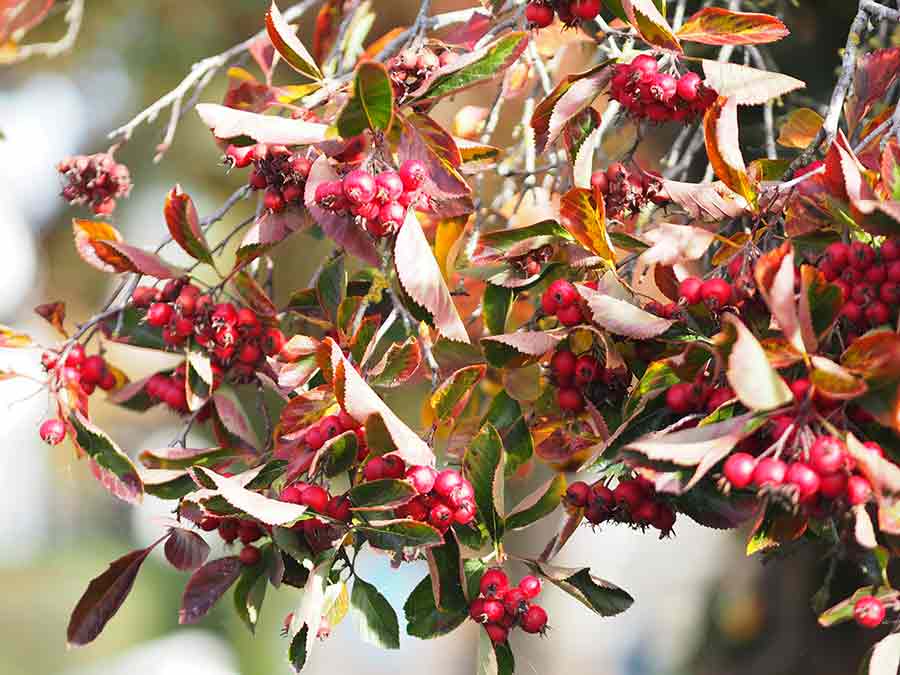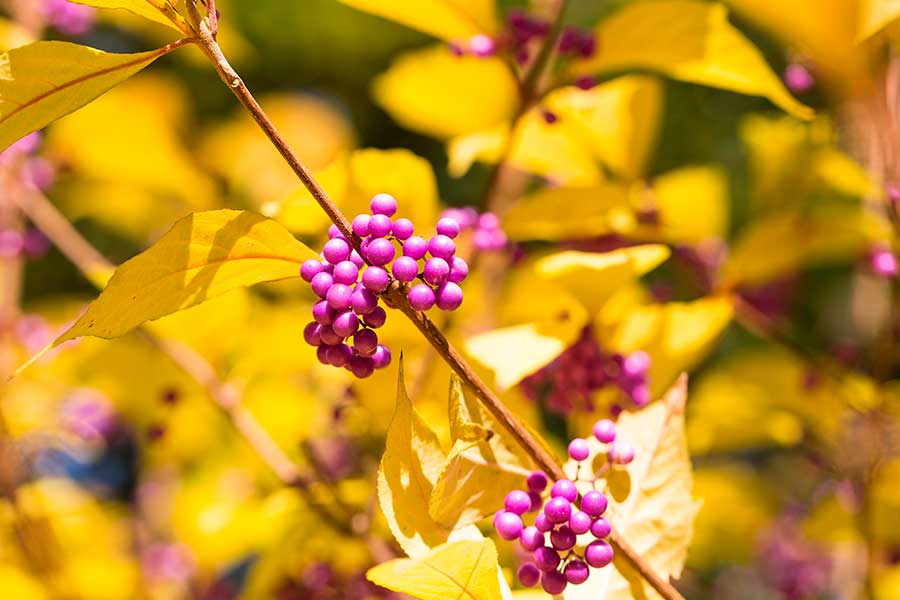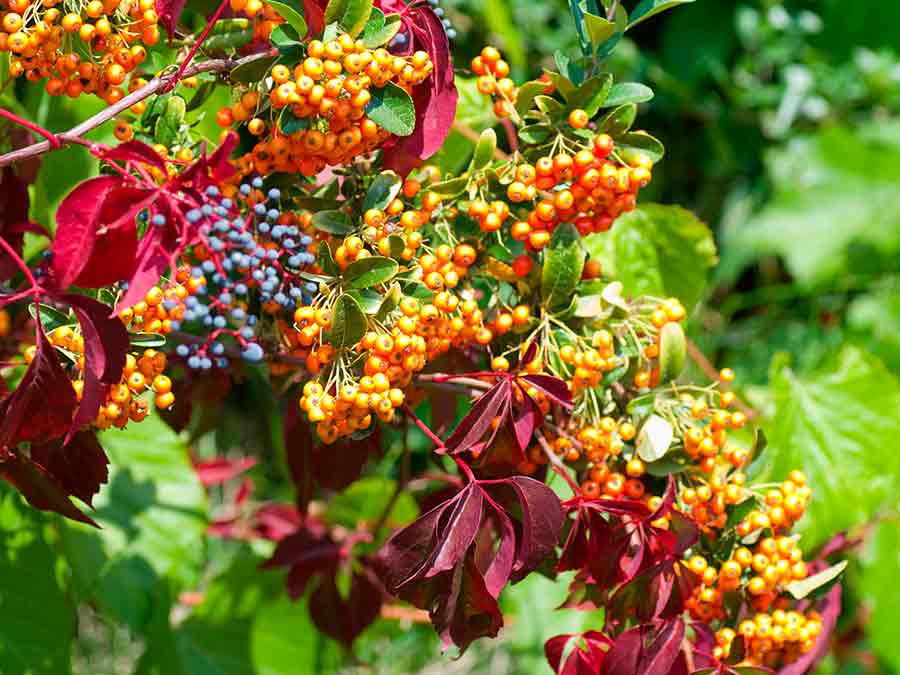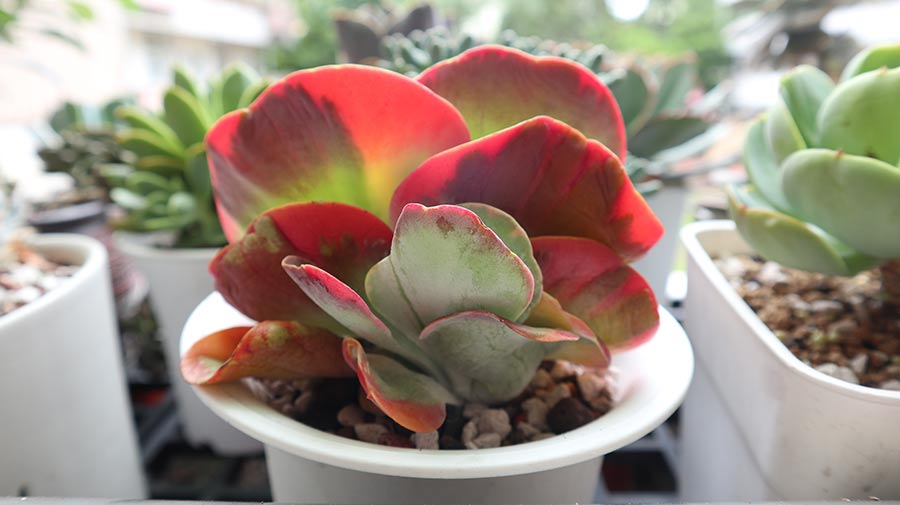- Home
- Leisure & Lifestyle
- Home & Garden
- 10 plants for autumn colour
Saying goodbye to summer can feel sad. But with the arrival of autumn, we can look forward to crisp, cool days, cosy evenings in, and, of course, the blazing colours this season is so famous for.
As the leaves turn various shades of red, yellow, and gold, and jewel-like berries appear on branches, there are still many vibrant flowers to be found. So if you’re looking to bring some autumn colour to your home and garden, you can find plenty of options.
Whether you want to turn your garden into a beautiful sea of crimson, russet, bronze, and gold, or bring warmth and vibrancy to the interior of your home, here are 10 of the best plants for autumn colour.
Outdoor plants for autumn colour
1. Acer

If you love the look of fiery foliage, it’s difficult to beat an Acer. Also known as maple trees, Acers are deciduous trees or shrubs that are famous for the spectacular display they put on each autumn.
There are many different types of Acers – though if you’re looking for leaves that’ll turn a flaming, fiery red, you might want to opt for the Japanese maple tree.
Other Acer options include ‘Sango-kaku’ – the coral-bark maple – which is known for its beauty throughout the year. With vibrant green leaves in summer; deep yellow leaves in autumn; and bare, bright red stems in winter, this tree will look lovely all year round.
Acers are compact trees and non-invasive growers, and while larger varieties look lovely in gardens, smaller varieties grow happily in containers and can look beautiful on patios or balconies. They grow best in lightly shaded positions and do really well beneath the shelter of taller deciduous trees. Just be aware that their delicate leaves need protection from strong winds or blazing direct sun.
For more information on Acers, have a read of this RHS guide.
2. Crab apple

Another tree that comes into its own in autumn is the crab apple. With red-flushed fruits and warm orange leaves, these eye-catching trees have gorgeous autumn foliage, and their beauty continues well into the winter months. Their fruits also provide food for birds in the colder part of the year, so they’re a smart option if you want to attract wildlife.
The Malus ‘Evereste’ crab apple is an excellent tree for smaller gardens, and its rosy-orange fruits look magnificent against its deep yellow leaves. Malus ‘Indian Magic’ is another option. It has bronze-tinged leaves and small coral-coloured flowers that appear in autumn and last until early spring.
If you don’t have much space, the Malus ‘Red Obelisk’, with its slender conical spread, is ideal. For more on the best types of crab apple trees, head over to Gardens Illustrated.
3. Callicarpa

If you’d like to add a more unusual colour to your garden, you might want to think about a callicarpa.
Better known as ‘the beauty berry’, this deciduous shrub sprouts clusters of pretty pink flowers in spring and summer, and when autumn rolls around, clusters of deep violet, bead-like berries appear on the purple-tinted leaves.
Even after the leaves have fallen, the glossy berries remain, injecting colour and beauty into your garden well into winter. You can also cut the berry-laded branches to make striking flower arrangements for your home.
These shrubs thrive in dappled shade. For more on growing callicarpa, you might want to have a read of this information from Gardeners World.
4. Pyracantha

Another plant that has beautiful, colourful berries is the pyracantha; a popular and hardy shrub that’s often grown as hedging, trained against a wall or fence.
Because it’s evergreen, it guarantees your garden always has some colour, even in the drab winter months. In autumn, an abundance of bright red, deep orange, or vibrant yellow berries appear. The berries remain throughout winter, and frothy white blossoms take centre stage when spring arrives.
If you want red berries, go for the ‘Red Column’ variety of the pyracantha, and if you’d prefer orange, opt for ‘Golden Charmer’. The ‘Flava’ variety produces bright yellow berries, while ‘Saphyr Rouge’ has clusters of coral berries.
Due to its dense, prickly stems, pyracantha also makes a great security fence. To find out more about growing pyracantha, check out this guide from the RHS.
5. Katsura tree

Another excellent autumnal option is a tree that smells as good as it looks: the katsura tree. Officially called Cercidiphyllum japonicum, the katsura tree originates from Japan, and this medium-sized deciduous tree looks fabulous during the autumn months when its leaves turn pink, yellow, and orangey-red.
Its smell is also a major plus. When autumn comes around, the fallen leaves give off a lovely sweet aroma – the smell of toffee apples, burnt sugar, or candyfloss, depending on who you ask!
The katsura tree is a spreader, so it’s best to plant it with a good amount of room. When young, the tree forms a conical shape, but it’s fast-growing and can spread to six metres.
To learn more about the katsura tree, why not head over to the Gardeners World website?
6. Autumn crocuses

If you’re looking for colourful flowers rather than trees or shrubs, what about the autumn crocus or the Colchicum?
These large blooms grow in September and last until late November, giving your garden a striking pop of colour. These goblet-shaped violet flowers appear out of nowhere – from the bare ground without any leaves – which is why their nickname is ‘naked ladies’!
In the spring, the leaves look lovely, but don’t be alarmed when they wither away – they’re just getting ready for their grand autumn show! If you’ve bought these flowers too late for them to bloom in the ground, you can keep them indoors and plant them in the spring to enjoy their colours next autumn.
To find out more about autumn crocuses, read this RHS guide.
7. Guelder-rose

The guelder-rose is another deciduous shrub that’ll brighten up your garden throughout the year. It has vibrant green, maple-like leaves that turn beautiful shades of red and purple in autumn and, in spring, the bushy foliage is cloaked with clusters of small, fragranced flowers that are a brilliant white.
In the autumn months, glossy red berries appear all over the foliage, attracting and feeding all kinds of birds, including bullfinches and mistle thrushes. And in winter, the guelder-rose’s berries are a favourite food of waxwings, which are pretty, pinkish-grey birds that come to the UK from Scandinavia. So, if you’re hoping to attract wildlife, this shrub is an excellent choice!
For more on the guelder-rose, you can visit Gardening Know How’s website.
Indoor plants for autumn colour
8. Amaryllis

If you’re looking to bring some autumn colours into your home, one of the best indoor plants is the Amaryllis.
These bulbs are incredibly easy to grow, so they’re perfect if you don’t have much gardening experience. All they require is soil, water, and indirect light – and their exuberant blooms will make an appearance six to eight weeks after planting.
These big, showy flowers are some of the most dramatic indoor plants, and with a wide array of colours – from red to orange to pink – you can really put on a colourful display. If you plant in early October, the flowers will bloom in November and last until Christmas.
For more on growing amaryllis, why not head over to the Gardener’s Supply Company website?
9. Croton

Crotons might not be the most unusual plant, but they’re popular for a reason. Not only are these houseplants really easy to grow, but their large, leathery green leaves are splashed with scarlet, orange, and yellow colours.
The ‘Eleanor Roosevelt’ variety has thin leaves that are often burgundy coloured and mottled with deep yellow, while ‘Oakleaf’ has glossy, leathery bronze leaves with scarlet, yellow, and orange veins.
Crotons are easy to care for, though be sure to keep them away from draughty windows. It’s also important to know that all parts of this plant are poisonous, so if you have pets who like to munch on plants (or curious children or grandchildren!), you should be extra careful.
For more on caring for crotons, you can visit Almanac’s website.
10. Paddle plant

Finally, why not think about adopting a succulent? Officially known as kalanchoe thyrsiflora, this unusual-looking plant is a real head turner that has a rosette of round, flat leaves.
The leaves are a cool green when kept inside. But if your paddle plant gets enough sunshine in winter, the edges of the leaves turn a glorious deep red, treating you to lovely seasonal colours.
Paddle plants often bloom with fragrant yellow flowers in spring, so if you’re lucky this plant will give you a treat twice a year. Like most succulents, it grows best in strong light and thrives when placed in a sunny spot for summer. Just be careful its leaves don’t scorch if there’s a heatwave!
For more on caring for paddle plants, check out the Guide to Houseplants’ website.
Final thoughts…
You don’t have to head to woodland or a park to enjoy the beautiful colours of autumn – and as this article shows, you don’t even need to leave your home!
If you have a garden, you can plant all kinds of gorgeous trees to brighten up your lawn, from the sweet-smelling katsura tree to the striking beauty berry. And, if you don’t have a garden, there are all kinds of attractive houseplants that’ll inject some warm autumnal colour into your home.
For more gardening ideas and inspiration, head over to the home and garden section of our website. You might also find it interesting to read our article; Why do leaves change colour in autumn? Plus 5 ways to use fallen leaves.
Do you have any plants that put on a show in autumn? Or are you tempted to buy some to add some colour to your garden or home? We’d love to hear about your gardening experiences in the comments below!
Selene Nelson is an author, freelance journalist, and lifestyle writer for Rest Less. After graduating from the University of Sussex with a degree in English Literature, Selene began contributing to many major newspapers and websites, and has written for the BBC, The Sunday Times, The Independent, Town & Country, and HuffPost. Her specialist subjects include food, travel, and health, though she enjoys writing about a wide range of topics (e.g. her two books are about veganism and psychopathy, respectively!). She enjoys cooking (particularly pasta and Asian noodle soups), reading, travelling, hiking, attempting to keep fit, and watching animal videos on YouTube.
* Links with an * by them are affiliate links which help Rest Less stay free to use as they can result in a payment or benefit to us. You can read more on how we make money here.
